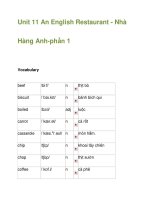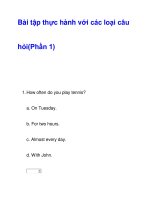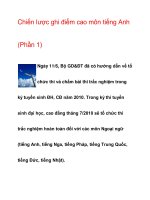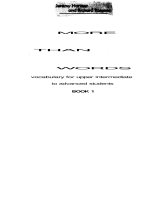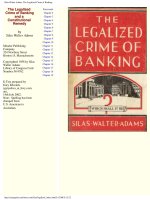Rapid GUI Development with QtRuby phần 1 ppsx
Bạn đang xem bản rút gọn của tài liệu. Xem và tải ngay bản đầy đủ của tài liệu tại đây (554.39 KB, 11 trang )
Rapid GUI Development with QtRuby
Caleb Tennis
The Pragmatic Bookshelf
Raleigh, North Carolina Dallas, Texas
BOOKLEET ©
Many of the designations used by manufacturers and sellers to distin-
guish their products are claimed as trademarks. Where those designations
appear in this book, and The Pragmatic Programmers, LLC was aware of
a trademark claim, the designations have been printed in initial capital
letters or in all capitals. The Pragmatic Starter Kit, The Pragmatic Pro-
grammer, Pragmatic Programming, Pragmatic Bookshelf and the linking
g device are trademarks of The Pragmatic Programmers, LLC. Qt® is a
registered trademark of
Trolltech in Norway, the United States and other
c
oun
tries.
Useful Friday Links
•
Source code from this book and
other resources.
•
Free updates to this PDF
• Errata and suggestions. To report
a
n erratum on a page, click the
link in the footer.
Every precaution was taken in the preparation of this book. However, the
publisher assumes no responsibility for errors or omissions, or for dam-
ages that may result from the use of information (including program list-
ings) contained herein.
To see what we’re up to, please visit us at
Copyright
©
2006
The Pragmatic Programmers LLC.
All rights reserved.
This PDF publication is intended for the personal use of the individual
whose name appears at the bottom of each page. This publication may not
be disseminated to others by any means without the prior consent of the
publisher. In particular, the publication must not be made available on the
Internet (via a web server, file sharing network, or any other means).
Produced in the United States of America.
Bookshelf
Pragmatic
Lovingly created by gerbil #40 on 2006-11-11
BOOKLEET ©
F
ridays
Contents
1 Introduction 1
1.1 Frameworks . . . . . . . . . . . . . . . . . . . . . . . . 1
1.2 Our Assumptions . . . . . . . . . . . . . . . . . . . . . 2
1.3 Acknowledgements . . . . . . . . . . . . . . . . . . . . 3
2 About Qt 4
2.1 A Little History . . . . . . . . . . . . . . . . . . . . . . 5
2.2 Versions . . . . . . . . . . . . . . . . . . . . . . . . . . 6
2.3 Where to get Qt . . . . . . . . . . . . . . . . . . . . . 7
2.4 How to install Qt from source . . . . . . . . . . . . . 8
2.5 Installation Issues . . . . . . . . . . . . . . . . . . . . 10
2.6 Exploring the toolkit . . . . . . . . . . . . . . . . . . . 11
3 About QtRuby 13
3.1 Language Bindings . . . . . . . . . . . . . . . . . . . . 13
3.2 I smell SMOKE . . . . . . . . . . . . . . . . . . . . . . 14
3.3 Installing QtRuby . . . . . . . . . . . . . . . . . . . . 14
3.4 Installation Issues . . . . . . . . . . . . . . . . . . . . 18
4 Get Your Feet Wet 19
4.1 Your first pr o gram . . . . . . . . . . . . . . . . . . . . 19
4.2 Objects and Widgets and Parents, oh my! . . . . . . 21
4.3 The Qt Object Model . . . . . . . . . . . . . . . . . . . 26
4.4 Other initialization items . . . . . . . . . . . . . . . . 30
4.5 The Qt::Application class . . . . . . . . . . . . . . . . 31
4.6 Summary . . . . . . . . . . . . . . . . . . . . . . . . . 33
BOOKLEET ©
F
ridays
CONTENTS CONTENTS iv
5 Take the Plunge 34
5.1 Your First Custo m Widget . . . . . . . . . . . . . . . . 34
5.2 Widget Geometry . . . . . . . . . . . . . . . . . . . . . 36
5.3 Understanding Layouts . . . . . . . . . . . . . . . . . 38
5.4 Automating a task . . . . . . . . . . . . . . . . . . . . 45
5.5 Signals and Slots . . . . . . . . . . . . . . . . . . . . . 47
5.6 Slot Senders . . . . . . . . . . . . . . . . . . . . . . . . 57
5.7 Summary . . . . . . . . . . . . . . . . . . . . . . . . . 58
6 Sink or Swim 59
6.1 Event Methods . . . . . . . . . . . . . . . . . . . . . . 59
6.2 Event Filters . . . . . . . . . . . . . . . . . . . . . . . 63
6.3 The Main Event . . . . . . . . . . . . . . . . . . . . . . 65
6.4 The Event Loop . . . . . . . . . . . . . . . . . . . . . . 66
6.5 Event posting . . . . . . . . . . . . . . . . . . . . . . . 68
6.6 Summary . . . . . . . . . . . . . . . . . . . . . . . . . 69
7 Home Stretch 70
7.1 Qt Modules . . . . . . . . . . . . . . . . . . . . . . . . 70
7.2 QtRuby tools . . . . . . . . . . . . . . . . . . . . . . . 72
7.3 Taking Advantage of Ruby . . . . . . . . . . . . . . . 75
7.4 Disposing of Widgets . . . . . . . . . . . . . . . . . . . 76
7.5 Debugging a QtRuby Application . . . . . . . . . . . . 77
8 Korundum 80
8.1 Installing Korundum . . . . . . . . . . . . . . . . . . . 80
8.2 Using Korundum . . . . . . . . . . . . . . . . . . . . . 81
8.3 DCOP—Interprocess Communication . . . . . . . . . 82
8.4 Summary . . . . . . . . . . . . . . . . . . . . . . . . . 87
Report erratum
BOOKLEET ©
F
ridays
CONTENTS CONTENTS v
A Event Method Map 88
B Resources 89
B.1 Web Resources . . . . . . . . . . . . . . . . . . . . . . 89
B.2 Bibliography . . . . . . . . . . . . . . . . . . . . . . . 90
Report erratum
BOOKLEET ©
F
ridays
Chapter 1
Introduction
1.1 Frameworks
Creating a graphical application with a scripting language isn’t new.
TCL, a popular scripting language of the early 1990s has Tk, a
graphical extension using the Mot if libraries. For years, these tool-
kits
were the defacto standard for creating GUI applications both
easily and quickly.
It’s probably no surprise that Ruby comes with libraries that sup-
port
TCL and Tk.
But, as t ime moves on, tools come onto the scene that provide new
features that users want. The GUI framework
Qt is one such tool,
b
uilt and refined over many years of use. Today, Qt is a powerhouse
frame
work, providing a top notch interface for building applications
on all three major computing platforms.
Qt and Ruby—A Lovely Marriage
We believe that Qt provides the perfect mix o f features for creating
robust GUI applications. We also believe tha t ext ending the use of
Qt into the Ruby domain gives us incredible power to create high
quality applications.
The choice of which toolkit to use is a personal one. For some devel-
We recommend you check out Qt’s excellent
online documentation.
opers, there is as much passion in the choice of toolkit as there is in
their choice of Ruby, Perl, or Python. When starting out with a new
framework like Qt Ruby, we r ecommend that you investigate all the
possible competing options before making any decisions.
BOOKLEET ©
F
ridays
CHAPTER 1. INTRODUCTION OUR ASSUMPTIONS 2
Other GUI/Ruby framework combinations are:
•
FXRuby (for the FOX toolkit)
•
wxRuby (for wxWidgets)
• Ruby/Gnome2 (for GTK)
•
RubyCocoa (for Cocoa)
1.2 Our Assumptions
In this book, we assume that you have some familiarity with Ruby—
t
hat y
ou understand and read Ruby code and can follow examples
in the book. If not, pick up a copy of Programming Ruby [TFH05].
We do not a ssume you have familiarity with
Qt, although, a moder-
a
te amount of familiarity will be a plus. For this, we recommend C++
GUI Programming with Qt 3 [BS04], which is also freely available on
the we
b (see Appendix B, on page 89).
We also assume you’re comfortable with your platform—Linux or
Mac—and that you are able to follow some of the instructions on
installing the software. We’ve attempted to make it as easy as pos-
sible, but some troubleshooting on your part may be required if
something doesn’t work right.
Last, w e assume that you will follow thro ugh the examples as they
are presented. Unfortunately, we don’t have the space or time to
discuss every aspect of the toolkit. However, after learning the fun-
damentals pr esented within, we feel confident that you will have
enough understanding of QtRuby to feel comfortable learning more
on your own.
Report erratum
BOOKLEET ©
F
ridays
CHAPTER 1. INTRODUCTION ACKNOWLEDGEMENTS 3
1.3 Acknowledgements
First, thanks to the developers who were responsible for QtRuby
and SMOK
E: Richard Dale, Ashley Winters, Germain Gara nd, David
Faure, and others.
Thanks to the developers at Trolltech who produce
Qt and provide
the GPL version to the open source community.
Thanks to the two Pragmatists, Andy and Dave, who provided input,
editing, and suggestions on the book.
Thanks to the Ruby community for being helpful and friendly to new
comers who tend to ask the same questions over and over again.
Finally, thanks to my wife, Anna, who put up with many evenings
of her husband paying more attention to this book than t o her.
Report erratum
BOOKLEET ©
F
ridays
Chapter 2
About Qt
If you are already familiar with Qt and installing it on your system,
you can skip ahead to Chapter 3, About QtRuby, on page 13.
Qt, by Trolltech, is a cross-platform GUI toolkit, written in C++ .
The original authors of Qt chose the name
based on the Xt, the X toolkit. The Q was used
instead because it looked nice in Emacs font.
Some of the main selling points of Qt are:
• Cros
s Platform—
Qt is available for Windows, Mac, and Unix. Qt
follows the mantra: write once, compile anywhere. You literally
o
nly ha
ve to write one program that, after being compiled, will
run on any supported platform.
• Modular—The toolkit comes with many modular, extensible
components, such as the
SQL, threading, and networking mod-
ules. While not all of these extra components are directly GUI
related, they are very helpful for adding functiona lity within
GUI programs while maintaining t he cross platform nature of
the toolkit.
• Open Source—Qt is licensed under the GPL. The source code is
f
ull
y available and completely free. Trolltech benefits by having
a large user base which can report feedback and pr o vide source
code patches for bugs found in the toolkit.
• Binary Compatibility—When a new version of the Qt toolkit is
rele
ased, it won’t alter the way your existing programs func-
tion. You can drop the latest version of
Qt in place and benefit
from bug fixes and feature additions withou t worry that some-
thing in your program will stop working properly.
BOOKLEET ©
F
ridays
CHAPTER 2. ABOUT QT A LITTLE HISTORY 5
2.1 A Little History
Qt was born in 1991 as a product to aid in GUI application develop-
ment.
In 1996, student Matthias Ettrich began using Qt as a basis
for the KDE project—an opensource Unix desktop environment. By
1997, the popularity of KDE and Qt was growing, but concerns
about Qt licensing issues were also starting to develop by members
of the open source community.
Some people involved within the open source community worried
about the dir ection of the Unix desktop.
Qt was the Unix desktop’s
main
toolkit, so having it controlled by a commercial entity worried
many people. In 1998, t he GNOME project was started to create an
alternative desktop that would be more compatible with the goals of
open source software.
Licensing
In response to the community’s moves, Trolltech licensed Qt under
the QPL,
an open source license. However, the Free Software Foun-
dation, the figurehead of the open source movement, did not regard
the
QPL as being compatible with t he GPL, its standard open source
license of the time.
In 2000,
Qt 2.2 was released under a dual QPL/GPL license which
allo
wed t he author using the toolkit to decide which of the licenses
they wanted their application to fall under. With
Qt 2.2, a fully GPL
compatible Qt was available for Unix. Since then, Trolltech has also
released versions of Qt under the GPL for Mac, starting with 3.1.2,
and for Windows, starting with 4.0.0.
Current releases of Qt are licensed under a dual commercial/GPL
license structure. This means that Qt is freely available, wit h full
Report erratum
BOOKLEET ©
F
ridays
CHAPTER 2. ABOUT QT VERSIONS 6
source code, on each of the three major platforms under the GPL.
This a
lso means that any software written using the Qt libraries
must abide by the
GPL.
A non-GPL commercial option also exists, allowing customers to
purchase a license from
Trolltech so that software written using
t
he toolkit can be licensed by the author. However, the source code
between the
GPL and commercial versions of Qt is the same.
1
Philosophy
It’s not our intention to dicuss the philosophy of softwar e licensing
in thi
s book. Instead, we want to make you aw are of the licensing
options of Qt and let you decide what works best for you. Before
beginning any QtRuby project, we encourage you to research you r
Qt license (GPL,QPL, or commercial) and what implicat ions it may
ha
ve o
n your project.
2.2 Versions
Qt is classified by it s major version number, with 4 being the most
recently released. Below the major version is a minor version num-
ber, like 4.0, and a patch level number, such as 4.0.0. Patch level
releases are done periodically to fix bugs that have been found in
the code. 4.0.1 represents the next patch level release from 4.0.0.
Minor version releases are done less frequently and usually involve
larger additions to the library, such as the addition of a new class.
1
There are some subtle differences, but for the most part there is no differ ence
in the commercial and GPL versions.
Report erratum
BOOKLEET ©


